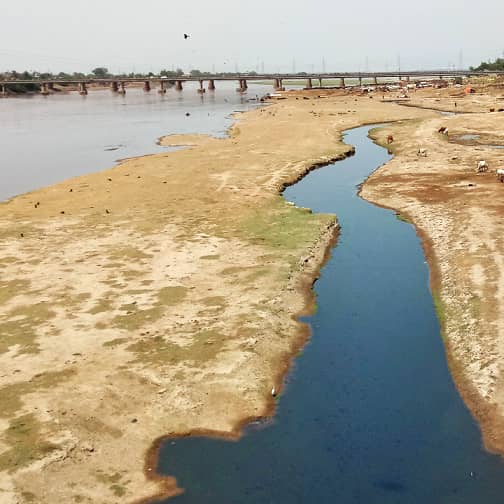Abu Bakar, a young boatman, is busy cleaning his boat on the banks of river Ravi. He has not used the boat for months.
Abu Bakar lives in Lahore’s Karim Park neighbourhood close to the Ravi. He takes visitors in his boat to a pavilion built by a Mughal prince, Mirza Kamran, in the middle of the river. He says the number of people visiting the pavilion increases every year between June and August because water flow in the river is higher during these months compared to the rest of the year.
Most of the water flowing through the Ravi nowadays is coming from a canal that links it with another river, Chenab, says Abu Bakar. The water flow in the Ravi is expected to increase further due to rains expected in the monsoon months of July and August.
In addition to water coming into the river from the canal and through rains, another type of water also enters it on a daily basis. It has an unpleasant odour that both the visitors and the boatmen have to endure throughout the year. In contrast to the normal brownish flow of the river, this water has a dark black colour and enters the river at many places through drains.
It, in fact, is liquid waste originating from various settlements of Lahore. It also contains chemicals discharged by factories in the city. This dirty and toxic fluid falls into the river through Lahore’s sewerage system.
The impacts of the pollution caused by this wastewater are visible everywhere on the river bank. Containing poisonous effluents from industries as well as urban human waste, it not only makes the Ravi stink, it has also caused a near extinction of wildlife and aquatic life in and around the river. Consequently, the riverine fauna and flora have been replaced by mud, cattle dung, heaps of rubbish and plastic bags.
The government officials planning to build a modern city on the Ravi claim they will clean all this up and turn the river into a pristine waterway with a sparkling clean current. Ravi River Front, the proposed city, will accommodate 12.5 million people on an area of 414 square kilometres. It will be located on both sides of the river a few kilometres northeast of GT Road.
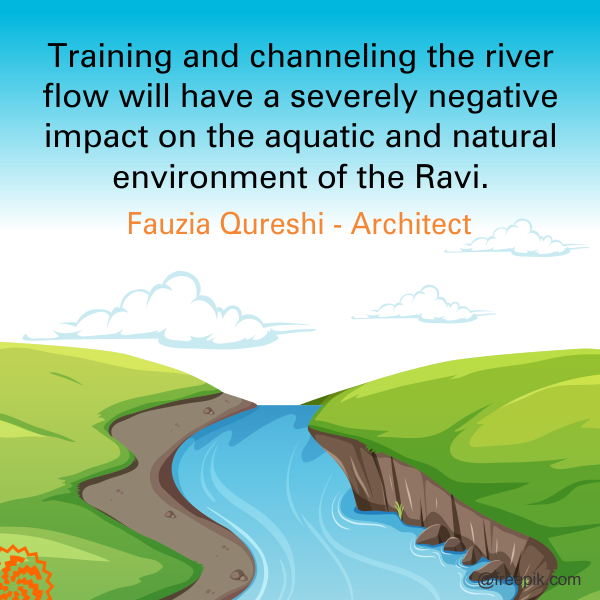
When Prime Minister Imran Khan inaugurated the project in August 2020, the Ravi Urban Development Authority, set up exclusively to implement it, immediately started working on it. The first step it took was land acquisition for which district administrations of Lahore and Sheikhupura were asked to identify residential, industrial and agricultural lands that could be purchased by using the Land Acquisition Act.
As soon as this process began, it faced a strong public reaction in several northern settlements of Lahore. This reaction led to the suspension of land identification in those areas. The acquisition process, however, continued uninterruptedly in the jurisdiction of Sheikhupura where not only land identification was completed but the government also started acquiring land from its owners.
Meanwhile, on 31st December 2020, a citizen named Haroon Farooq filed a petition at the Lahore High Court, seeking a halt to the Ravi River Front project because the government had not conducted its environmental impact assessment before starting it -- even though this was a legal requirement.
Hearing the petition the same day, the court directed the Punjab government to suspend the project until a detailed assessment of its environmental impacts was carried out and approved by the Punjab Environmental Protection Department.
Conflict of interest
To implement the court order, the Punjab government hired the services of a firm, Engineering Consultancy Services Punjab Private Limited. Set up in 2011, it appears to be a private company but is not. It is actually owned by the Punjab government and its board of directors includes several senior provincial administration officials.
The firm completed its assessment in a few days but its critics say it was a wrong move by the government to have given it the task of assessing the project’s impact. Being a government-owned entity, they point out, it could not have done its work independently of the government’s preferences and policies.
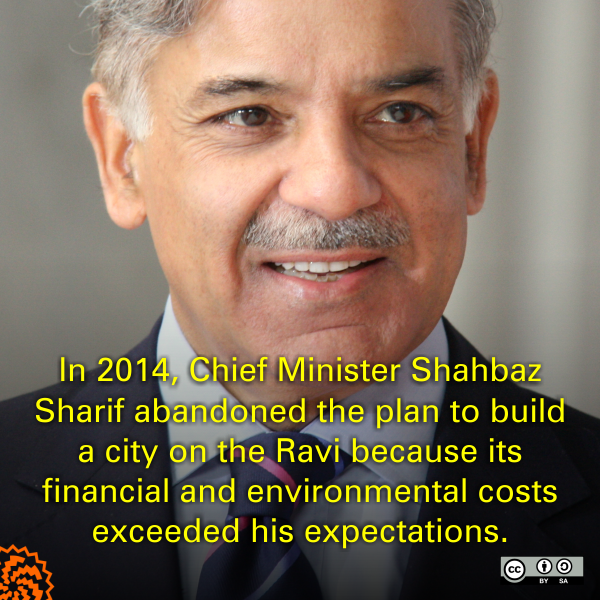
The Human Rights Commission of Pakistan has raised this point in a report and demanded that the environmental impact assessment be entrusted to a company which has the expertise and capability to do it independently. Saima Amin Khawaja, an environmental lawyer and a member of the state-supported National Commission on Climate Change, similarly says the government agencies do not take environmental issues seriously and never work on them independently of the government’s agenda.
She also objects to the fact that the Engineering Consultancy Services is not registered with the Environmental Protection Department even though, she says, it is required by law to have been registered there.
Yasin Hatif, a Supreme Court lawyer and a legal adviser of the Engineering Consultancy Services, however, dismisses these objections. He says the Punjab Environmental Protection Act 1997, the law that governs the working of Punjab’s Environment Protection Department, does not explicitly state that the task of assessing environmental impacts of development projects should be assigned only to independent entities. Under that law, he says, “even the owner of a proposed building can submit such a report”.
Hatif also claims that “a company assessing the environmental impact of a construction project does not have to be registered with the Environmental Protection Department”. This, he says, is due to the fact that rules and regulations in this regard have not been formed yet so “there are no guidelines on whether or how to register a company with the department”.
Same project, same problems
The language, findings, statistics and even the layout of the material used in the Engineering Consultancy Services report are largely the same as those used in a 2014 report prepared by a Singapore-based company, Meinhardt, which reviewed the construction and financing of a similar project back then. It was assigned the task of preparing the report by the then Punjab Chief Minister Shahbaz Sharif because he, too, intended to build a city on the Ravi. After the completion of this report, though, he abandoned the plan because its financial and environmental costs exceeded his expectations.
The Engineering Consultancy Services report also includes some figures that are hard to believe. The Minehardt report, for example, only stated that the Ravi River Front project would create jobs. The new report claims the number of such jobs will be as high as 7.7 million.
Another key difference between the two reports is that the agricultural land required for the project was estimated by Minehardt to be 41 per cent of the total land needed for it. The new report, in comparison, estimates the agricultural land to be 77 per cent of the total project area. The main reason for this difference is that the current project’s geographical boundaries are different from those of the previous plan. The area Meinhardt was surveying included land belonging to only two villages in Lahore and Sheikhupura districts but the new plan includes land belonging to 89 villages -- 20 of these being in Lahore district and 69 in Ferozewala tehsil of Sheikhupura district.
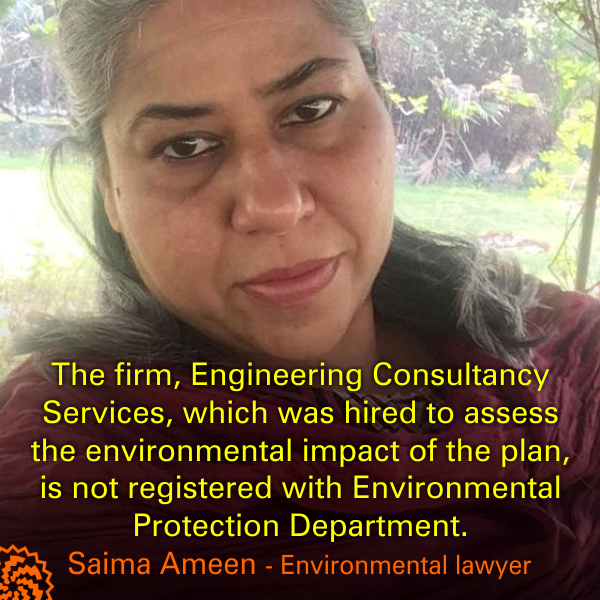
These differences notwithstanding, there is little distinction between the two reports as far as the environmental impacts of the project are concerned. To cite just one example, the Meinhardt report found 109 species of wild and aquatic animals in the proposed area of the project; the new report puts their number at 116. The Meinhardt report, similarly, stated the number of plants found in the proposed area of the project to be 146; according to the new report, this number is 147.
Criticism of the report
After completing its report, Engineering Consultancy Services submitted it to the Environmental Protection Department which announced that a public hearing would be held on 20th February 2021 to record the views of people living in the proposed area of the project about it.
When the hearing took place, it triggered protests by several farmers from Sheikhupura district. They alleged that they were being kept out of it deliberately while a number of other people were participating in it without having anything to do with the Ravi River Front project.
Instead of responding to this objection, officials from the Environmental Protection Department insisted that the financial resources needed to cleanse the Ravi and improve its aquatic and natural environment could only be available if private sector was encouraged to invest in building a city on it.
While presenting the environment assessment report during the hearing, the department’s spokesperson concluded his remarks by saying: “je ravi vich paani koi nai, te apni kahaani koi nai” (if there is no water in the Ravi, the story of our lives cannot go on).
But, as Khawaja says, if the most important objective of the Ravi River Front project is to bring clean water to the Ravi, then why is the government acquiring about 100,000 acres of residential, agricultural and industrial land for it? This land certainly cannot produce water needed to rehabilitate the Ravi, she says, so the government will have to make some other arrangement for it.
The government planners say that most of the clean water will be brought to the Ravi through 14 drains which, as per estimates by the Engineering Consultancy Services, are pouring 3,000 to 4,000 cusecs of wastewater daily into the river from different parts of Lahore. The environmental impact assessment report of the Ravi River Front project proposes that seven treatment plants be built to treat this water before it is discharged into the river but even the government planners believe that these plants will be able to purify a maximum of 1,310 cusecs of water each day – and, that too, by 2045. The remaining sewage will continue to pollute the Ravi even after the construction of a new city.
Farmers and members of the civil society who attended the public hearing also pointed out that the machinery required to clean up the urban wastewater is so expensive that its installation would drastically increase the cost of the proposed city and, consequently, no investor from private sector will like to get involved in it. They also said that a commission of experts set up in 2011 on the orders of the Lahore High Court to clean up the Ravi had rejected a proposal to set up such plants to treat sewage water on the grounds that their Installation was not only a very expensive proposition but the government also does not have the technical and financial resources to keep them running.
Fauzia Qureshi, an architect and a member of the Women’s Action Forum, an organization working on women’s rights, also raised objections during the public hearing over the proposed move to train and channel the river flow. This will have a severely negative impact on the aquatic and natural environment of Ravi, she said.
Also Read
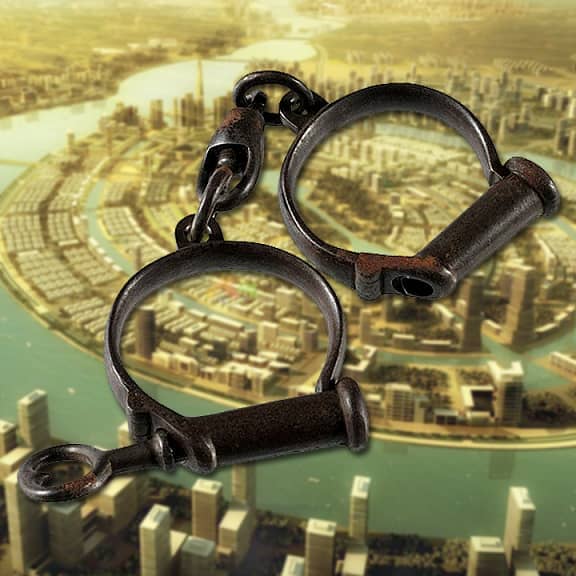
Opposition to Ravi river front housing project: Government arrests farmers to take over their land
The Engineering Consultancy Services report also acknowledges that the construction of the Ravi River Front will adversely affect 12 of the 14 environmental indicators in its proposed area. How these negative effects will be addressed is something that the report is silent about, says Khawaja.
She also does not trust the government agencies involved in carrying out the project. How these agencies will solve the problems of air and water pollution in the new city if they cannot address the same problems being faced by the current populace of Lahore, she asks.
A tale of two cities
According to the Ravi River Front project, people living in the new city will need 890 cusecs of water per day – 70 per cent of which will be extracted from underground. As a result, groundwater levels in the proposed area of the project will fall progressively. The remaining 30 per cent of water will be taken from Punjab’s canal system which will reduce the supply of water available for irrigating crops.
Similarly, the new city will generate 11,000 tons of garbage every day, which will require billions of rupees worth of machinery and thousands of workers to pick it up and dispose it off. In addition, landfills will have to be set up over large tracts of land -- and by using expensive modern technologies -- to handle this waste in a scientific way. Otherwise, the situation of the new city will be similar to that of Lahore where the government agencies cannot handle even 5500 tons of garbage daily and where the landfills built in Lakkhodehr and Mahmood Boti areas are causing large scale contamination of groundwater.
Based on these numbers, Khawaja says that water and air pollution problems around the river will increase with the implementation of the Ravi River Front project to such an extent that people will be unable to breathe.
Dr Nasir Javed, former head of The Urban Unit, a Punjab government agency, does not agree with her. During a television talk show, he supported the Ravi River Front, citing the example of a Chinese city, Shenzhen. He said the population of Shenzhen was 40,000 in 1984 but it has increased to 15 million now.
What he did not mention was that Shenzhen is facing serious air pollution after its massive population expansion. According to the International Water Association, a global non-governmental watchdog, the city is also experiencing flooding and water shortages simultaneously.
This report was first published by Lok Sujag on 3 Jul 2021, on its old website.
Published on 21 May 2022
